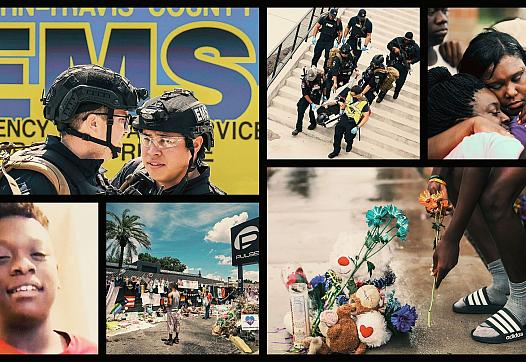Trauma Deserts In Rural America: Where You Live Can Determine Whether You Live
The story was originally published by The Dallas Morning News with support from our 2022 National Fellowship.
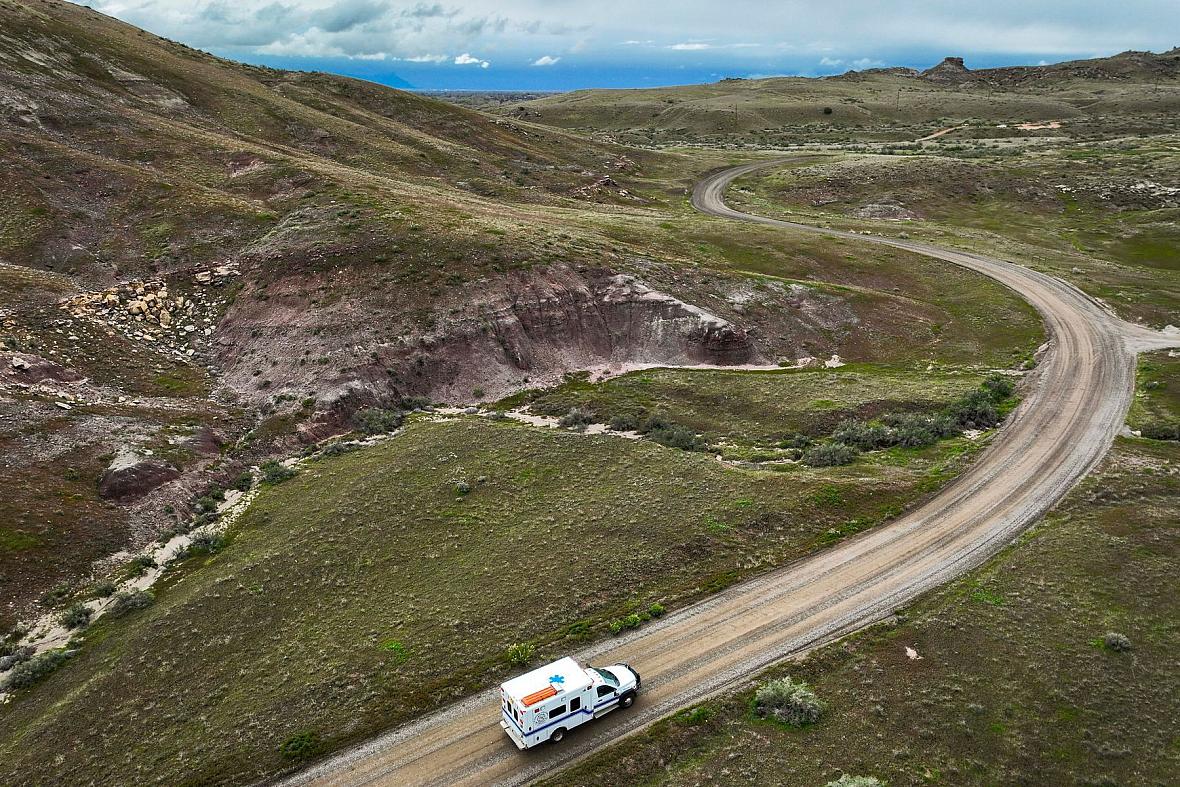
A Lower Valley Fire District ambulance drove along a dirt road through the Horsethief Canyon State Wildlife Area after a training exercise near Fruita, Colo., last April. The American West, with its expansive geography and extensive trauma care deserts, poses unique challenges for emergency medical providers.
Smiley N. Pool / Staff Photographer
GRAND JUNCTION, COLO. — Late one night last year on the western edge of Colorado, a car careened off a cliff and landed at the bottom of a ravine.
A few miles from the city center, rescue and emergency medical workers converged where the car had flattened hundreds of feet below.
By the time an air ambulance service arrived, there was no easy way for paramedics to reach the only survivor, a man with head and chest injuries. They couldn’t safely land the chopper at the bottom. And then there was the incline, which was too steep to hike down.
The one thing they had on their side was the fact that the crash happened just five minutes by air from St. Mary’s Medical Center, a Level II trauma center that serves the western portion of the state. Still, it took hours to set up ropes and harnesses so emergency responders could rappel down to the injured man. His condition was serious, and he was still in the wreckage. Paramedics didn’t want to delay his treatment, so they began a transfusion of red blood cells before lifting him up to the chopper.
The man made it to the hospital — alive.
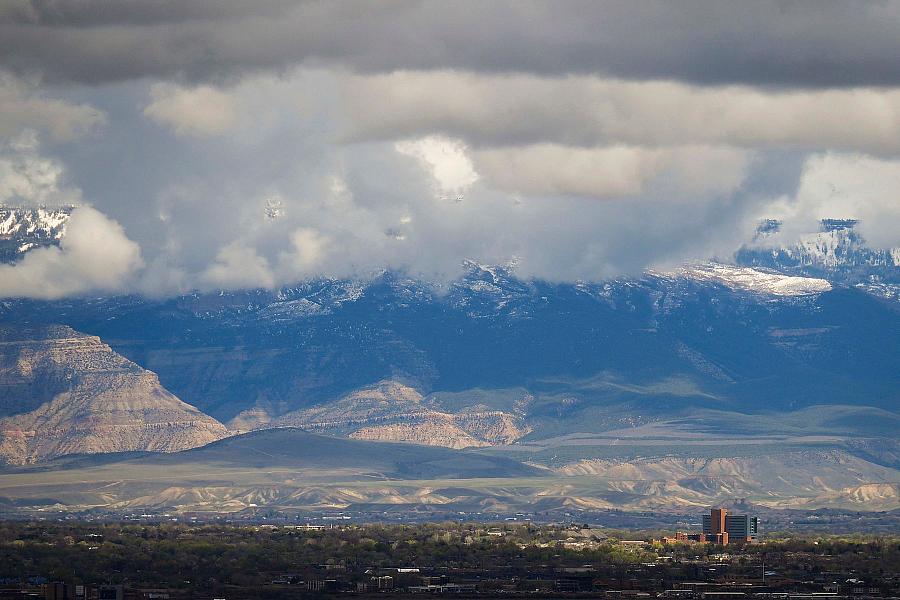
St. Mary's Medical Center, the largest hospital and only Level 2 trauma center between Denver and Salt Lake City, can be easily spotted from the Colorado National Monument rising above all the other buildings in Grand Junction, Colo. The Rocky Mountains act as a dividing line for trauma care in Colorado, and St. Mary’s serves the entire western portion of the state.
Smiley N. Pool / Staff Photographer
The dramatic rescue is not unusual for the American West, where expansive geography and extensive trauma care deserts pose unique challenges for emergency medical providers — and imperil the lives of people who suffer critical injuries.
Unlike urban areas where trauma hospitals are easily accessible, in this part of the country injured patients can be several hours away from help. As a result, patients are more likely to succumb to their injuries before reaching a hospital, according to an analysis of federal data by The Dallas Morning News, in collaboration with medical researchers from the University of Alabama at Birmingham.
Each year, medical researchers estimate tens of thousands of Americans bleed to death despite having injuries they could have survived, a reality that trauma physicians have decried as a health crisis. Traumatic injury is the top killer of children and adults under the age of 45, claiming the life of an American about every 3½ minutes. Yet medical specialists argue it receives little federal funding for research that could help improve outcomes compared with other leading causes of death.
Nationwide, paramedics often lack the tools they need to treat severe internal bleeding, and patients have sporadic access to lifesaving interventions like blood transfusions before arriving at a hospital. Injured patients routinely bleed out before reaching a doctor, despite scientific advances that make blood transfusions on ambulances possible.
For decades, trauma specialists posited that seriously wounded patients should be treated at an equipped hospital within the “golden hour” immediately following their injuries. More recent research from the past several years suggests the critical window is closer to a half-hour for severely bleeding patients, whose risk of dying grows with each minute they don’t receive blood and other crucial treatments.
Above-average proportions of people dying of their injuries before they reach a hospital indicate more lives could potentially be saved, researchers say.
The News’ analysis found trauma care in the U.S. is starkly inequitable, in that where you live can determine whether you survive. Nationwide, there is unequal access to emergency medical services and trauma hospitals equipped to treat the most severe injuries. The problem is most severe in the more rural West and South.
The News used Centers for Disease Control and Prevention mortality statistics to compare the number of prehospital to in-hospital trauma deaths for all U.S. states and most counties from 1999 through 2020. It also mapped the locations of high-level trauma hospitals nationwide and calculated the approximate travel times to them for every part of the U.S.
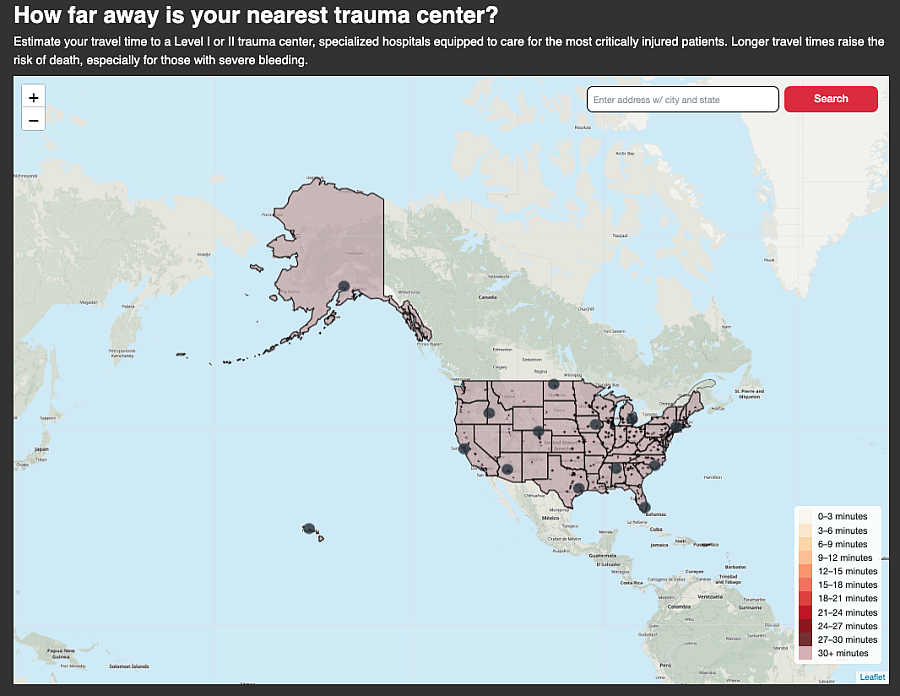
These analyses show:
- An estimated quarter of all Americans live further than a 30-minute drive from Level I or II trauma centers, which provide the highest level of care to injured patients. In rural areas, the risk of death is greater due to longer response and transport times, research shows.
- Western states, with their vast expanses and rugged terrain, are far less equipped to treat critically injured patients than densely populated regions like the East Coast. In the region that includes Alaska, Idaho, Oregon and Washington, about 63% of trauma victims die before reaching a hospital compared with about 41% in the best-performing region, covering Connecticut, Massachusetts, Maine, New Hampshire, Rhode Island and Vermont.
- Many states in the West — Wyoming, Montana, South Dakota, Idaho and Alaska — have no Level I trauma centers. Washington, Oregon and Utah have just one or two of these specialized hospitals each, according to data from the American Trauma Society, for a combined population of more than 15 million people.
- Residents of Western states must travel significantly farther to high-level trauma centers. People in Montana, North Dakota, South Dakota, Wyoming, Utah and Colorado are, on average, roughly 5.3 times farther from trauma hospitals than people in New York or New Jersey, a News analysis of census data shows.
- Parts of the South performed worse compared with the coasts. Texas had the 17th-worst rate of prehospital deaths, and huge swaths of the state lack timely access to high-level trauma centers.
In parts of Colorado and the surrounding region, the remote terrain leads to heavy reliance on volunteer emergency medical providers, who often respond less quickly and tend to lack the training and resources to treat major bleeding compared with providers in more populous areas.
“If you’re in downtown Dallas, you call an ambulance, you have five paramedics on scene in five minutes,” said Dr. Glenn Burket, EMS medical director for Mesa County in Colorado, who advised paramedics by phone during the ravine rescue.
“People have to have that understanding of, if you go out in the backcountry, you’re on your own.”
RURAL-URBAN DIVIDE
For a week last spring, The News traveled to western Colorado, reporting on the ground from small towns isolated by mountains and wilderness. With the country’s ninth-worst proportion of prehospital trauma deaths and a neighbor to states that fared even worse, Colorado is emblematic of the challenges rural states face in delivering high-quality trauma care across remote landscapes.
Running through the heart of the state, the Rocky Mountains act as a dividing line for rapid access to care for seriously injured patients.
The eastern portion of Colorado includes the state’s 10 most populous counties, home to around 4.7 million people. The region contains 16 trauma centers equipped to provide the highest level of injury care.
On the western side of the mountains, there is one such hospital — St. Mary’s in Grand Junction.
The next closest hospitals to St. Mary’s are nearly 240 miles away, in the Denver area or Provo, Utah. The area surrounding Grand Junction is replete with national parks and wilderness areas, resulting in high numbers of patients with injuries from recreational activities.

A mountain biker prepared to 'drop off' into the Lunch Loop Bike Park in Grand Junction, Colo., in April. Tourism and its related outdoor sports can provide challenges for emergency health care providers in the western portion of Colorado.
Smiley N. Pool / Staff Photographer
The locations make sense for the hospitals, which need a steady volume of patients to treat. Most of the state’s residents are concentrated in the areas around Denver, Boulder and Colorado Springs.
But it leaves many of Colorado’s counties, more than half of which are rural, without timely access to care when people are seriously hurt, according to a 2019 study by researchers at Colorado State University and University of Colorado Health.
The study, which analyzed differences in trauma outcomes across Colorado over two five-year periods, found rural counties — which tended to be an hour’s drive or more from high-level trauma centers — had significantly higher rates of injury-related hospitalizations and deaths than urban areas. The trauma mortality rate for rural counties was 93.8 deaths per 100,000 people, compared with 71.6 for the state’s other counties.
While air ambulances can provide advanced life support in remote settings, extreme weather like high winds and snowstorms often prevent helicopters and planes from flying, the researchers noted.
“Rural areas face challenges beyond the locations of trauma centers,” the researchers wrote. “There are fewer prevention resources, higher injury rates, longer emergency response and transport times, and emergency medical services have limited capacity and capability.”
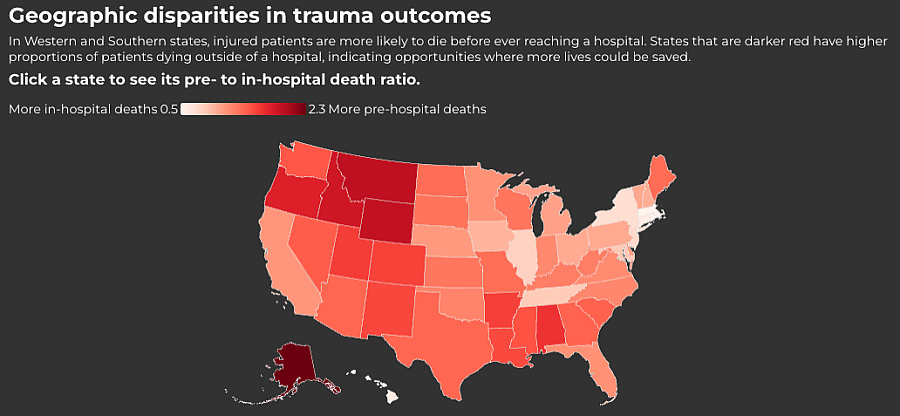
UNEQUAL RESOURCES
The disparities in Colorado reflect the unequal access to trauma hospitals and emergency care across the American West.
Dr. Julie Dunn, one of the authors of the study on Colorado trauma outcomes, said she has spent her career trying to dissuade people of the notion that every hospital emergency department is equipped to handle complex trauma. Her hospital, UCHealth Medical Center of the Rockies in Loveland, was designated as a Level I trauma center in July 2022.
Dunn’s hospital receives patients from rural towns on the eastern plains of Colorado and from as far as several hours away in southwest Nebraska and Wyoming, where hospitals don’t have enough resources to treat severe bleeding. The condition those patients arrive in depends on whether the hospitals where they were stabilized had a surgeon on staff, Dunn said.
Those small hospitals can usually resuscitate hemorrhaging patients, but they are not equipped to stop the bleeding altogether, said Dunn, who also leads a regional trauma committee for the American College of Surgeons that includes Colorado, Wyoming, Montana, Utah and the Dakotas.
Because of the dearth of high-level trauma centers in this part of the country, the most seriously injured patients must first go to a lower level trauma center or non-trauma hospital, or travel longer distances, delaying treatment, Dunn said.
Many of these states have the highest proportions of people dying before they reach a hospital, the analysis with the University of Alabama at Birmingham found.
Parts of the South, including Arkansas and Alabama, also have high proportions of prehospital trauma deaths.
The News’ analysis is based on a 2018 study that linked state levels of prehospital trauma deaths to timely access to high-level trauma centers. Dr. Zain Hashmi, a UAB trauma surgeon and the study’s lead author, said he often sees patients from rural parts of Alabama who are near death because of how long it took to reach him.
“It’s really, really sad to see those patients, because we could have made a difference, truly,” he said.
He also recognizes that little data is available on the circumstances of injured victims who die before reaching a hospital. Those patients may never be evaluated by a medical professional, and local rules dictate whether they undergo an autopsy.
“That’s a big black hole of information right now,” Hashmi said.
On the East Coast — where states are smaller, population density is higher and trauma centers are more available — fewer patients die before reaching a hospital. Some cities have outsized trauma resources. Boston, a city of less than 700,000 people, has five adult Level I trauma centers — more than the states of Oregon, Washington and Nevada combined.
Dr. Joseph Amos, trauma medical director for Methodist Health System in Dallas, studied the growth of trauma centers in certain parts of the country for a 2021 paper published in Trauma Surgery & Acute Care Open. In one area of Florida, his research team discovered for-profit hospital systems were choosing to become trauma centers — not out of need but because funding was available for facilities that treated uninsured trauma patients.
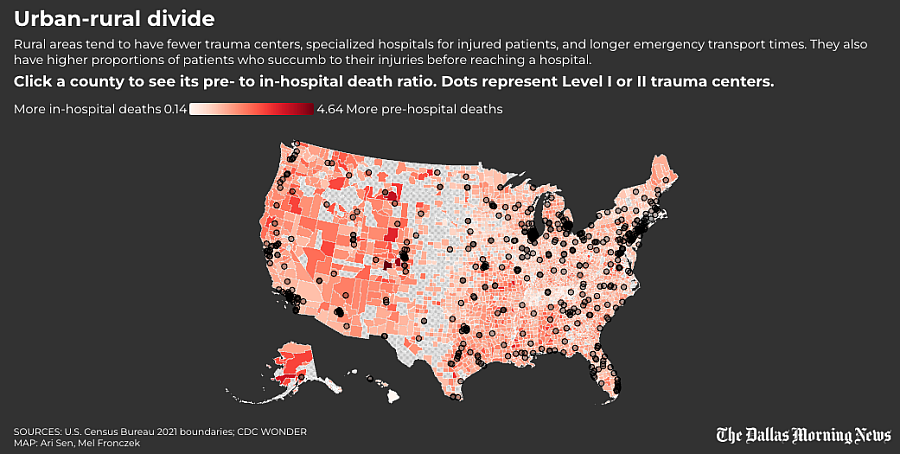
Nationally, no one regulates the placement or expansion of high-level trauma centers in the U.S. In Texas, they increased by nearly 40% over the last decade, according to Amos’ study.
Dr. Ernest Moore sees a similar pattern in his city, where what was then called Denver General Hospital used to be one of two trauma centers in the metro area. Now, the city has “so many I couldn’t count.” The duplication of services hampers research and education. When hospitals treat larger numbers of patients, trauma specialists gain expertise and patient care improves, Moore said.
Meanwhile, other parts of the state remain starved of resources. The News’ analysis shows about 82% of trauma victims in Gunnison County, home to around 17,000 people in the heart of the mountains, died before reaching a hospital, compared with around 50% in Denver County, the state’s best-performing county.
“We have way too many trauma centers along the front range of the mountains — we have too many in Fort Collins, too many in Denver, too many in Colorado Springs,” said Moore, who served as chief of trauma at Denver Health for nearly four decades.
‘BEAUTIFUL YET HOSTILE’
When CJ Malcolm moved to Colorado in late 2015, he was looking for a challenge.
For years, he had worked for the National Park Service, first as a ranger paramedic at Grand Teton National Park and Yellowstone, then managing the search and rescue program at the Grand Canyon.
When a job opened for chief of emergency services in Gunnison, a town of about 6,500 at the bottom of a valley in the Rockies, he wanted it. Covering around 4,400 square miles of mountains and backcountry, his jurisdiction was massive, one of the largest EMS districts in the state.
There was something about the landscape, beautiful yet hostile, and the challenge it presented, that attracted him.
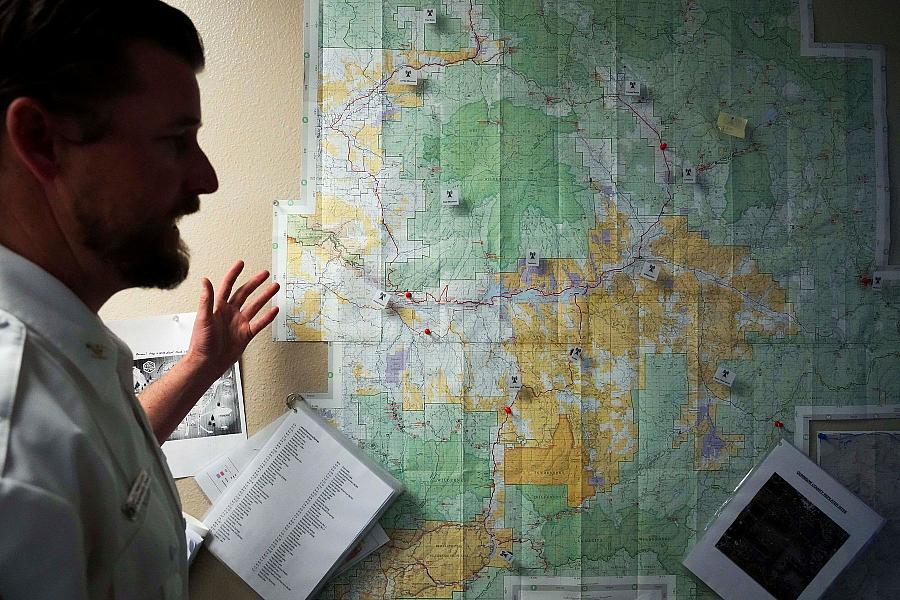
CJ Malcolm, chief of Gunnison Valley Health Paramedics in Gunnison, Colo., goes over a map of his service's expansive and rugged coverage area, the largest in the state. It covers around 4,400 square miles of mountains and backcountry.
Smiley N. Pool / Staff Photographer
In the past eight years, Malcolm and his medics have grappled with a fast-growing demand for emergency services due to a growing population and tourism.
His paramedics must often transfer patients with serious illnesses and injuries from Gunnison Valley Health Hospital, where there’s no intensive care unit, to other facilities for a higher level of care. Those transports can be delayed if the only road into town is blocked by snow or other bad weather.
The nearest high-level trauma center, in Grand Junction, is more than a two-hour drive. Level I trauma centers in Denver and Colorado Springs are more than three hours away.
Chris Rowland, EMS coordinator for Mesa County, which includes Grand Junction, said he and other people move to places like rural Colorado for the freedom that comes with living outside urban areas.
That freedom comes with unforeseen trade-offs.
“People deserve good quality care, but I also think they have to take into account where they choose to live,” Rowland said. “If I choose to live four hours away from a trauma center, that’s my conscious choice that I made ahead of time.”
Visitors from big cities may expect faster response times than what might be possible in a place like Gunnison, where paramedics carry backcountry bags in case they are forced to make camp with patients until weather conditions improve. At times, paramedics must respond to calls by hiking or using snowmobiles or all-terrain vehicles.
At least once a year year, Malcolm’s team — which runs around 1,600 annual calls for injuries, medical emergencies and hospital transfers — responds to a patient in an extremely remote area whose care consumes about 24 hours. His paramedics’ calls run several hours longer, on average, than those in big cities.
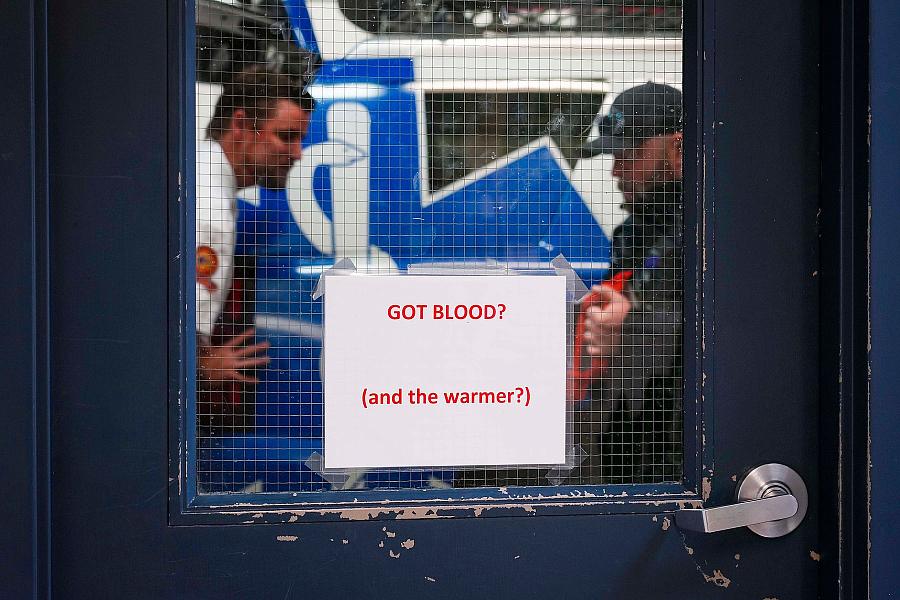
A sign reminds staff to prepare blood and a blood warmer before they go out on emergency calls as CJ Malcolm, chief of Gunnison Valley Health Paramedics, and operations Capt. Nick Zuber work in a bay at the EMS station. In 2020, Gunnison Valley Health Paramedics became one of the first ground ambulance services in the state to carry blood products on trauma calls.
Smiley N. Pool / Staff Photographer
It’s one of the reasons why Gunnison Valley Health Paramedics, which started as a mostly volunteer service, now hires medics with military backgrounds and is equipped with advanced life support ambulances, including some roomy enough to sleep in during extended calls.
In 2020, it became one of the first ground ambulance services in the state to carry blood products to trauma calls, recognizing it might be hours until critically injured patients make it to an emergency department. Earlier this year, emergency medical providers across Colorado formed a coalition to explore the creation of a statewide prehospital blood program.
The program will have to overcome a fundamental paradox of rural trauma care, said Dr. Shay Krier, Gunnison’s EMS medical director. Outside of cities, fewer patients will need transfusions, putting units of blood at risk of expiring before they can be used. At the same time, extended travel times to hospitals make having blood on hand all the more urgent.
Burket, the EMS medical director in Grand Junction, said it might make more sense for rural paramedics to stock something like freeze-dried plasma, which is shelf-stable until it is reconstituted with water. Such products are used in countries like France and Germany but have not been approved by U.S. regulators.
About a half-hour up the mountains from Gunnison, Crested Butte Fire Protection District has faced its own reckoning.
Early in his tenure as EMS and fire chief in the quaint ski town, Rob Weisbaum saw that the agency’s response times were dangerously slow. It took volunteers so long to reach a burning building in view of the fire station in 2015 that the occupant had already escaped. The fire killed a dog that was inside.
The incident was a wake-up call, Weisbaum said. The department needed to do better.
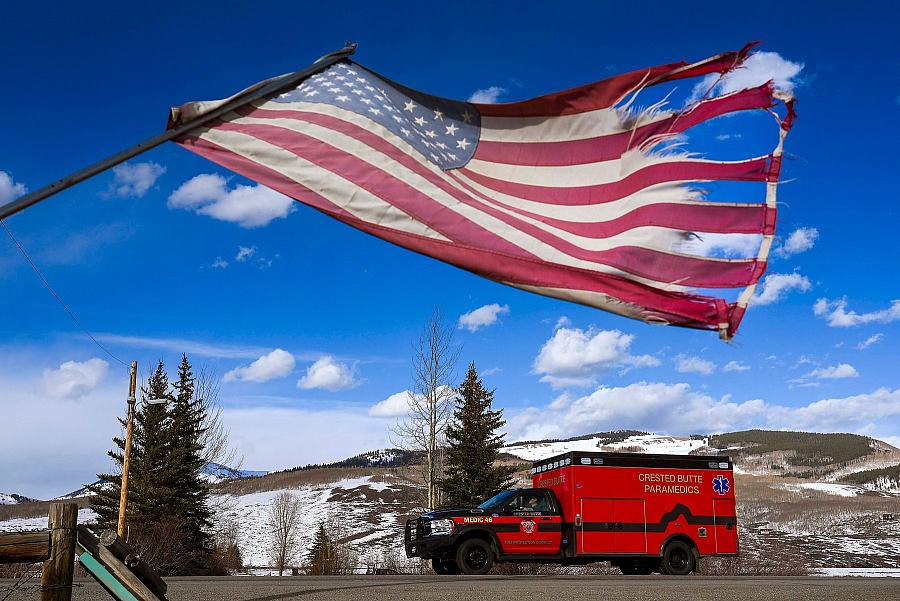
A Crested Butte Fire Protection District ambulance moves between stations in Crested Butte, Colo. In 2022, Colorado lawmakers created a task force to study ways to preserve and expand access to emergency care across the state, especially in areas that are far from high-level trauma centers.
Smiley N. Pool / Staff Photographer
Now, Crested Butte has fully equipped response vehicles and three outlying fire stations outfitted with bedrooms and kitchens so paid staff can rest, and be ready, when a call comes in. The department has an agreement with Gunnison to share blood, if needed.
When Weisbaum flies to Denver, he is reminded why his department needed to be better prepared to respond to life-threatening calls.
“We’re at 9,000 feet here, and we’re constantly flying over 14,000-foot mountains,” he said. “It gives you an appreciation of the vastness of the forest and the mountains.”
‘LIMPING IT BY’
For many EMS agencies across rural Colorado and other Western states, the advanced care provided in Gunnison and Crested Butte is not currently possible.
Affluent taxpayers support Crested Butte’s ambulance service, while the local hospital and private donations subsidize Gunnison’s paramedics.
Earlier this year, Malcolm secured a major funding increase for his department after appealing to the Centers for Medicare and Medicaid Services, based on a provision in the agency’s rules. As the only ground ambulance service in the area that transfers patients to other hospitals, his agency is entitled to an additional $500,000 to $1 million each year from the federal government — a significant proportion of Gunnison paramedics’ $3.5 million annual budget. The additional money will bring the service closer to breaking even, Malcolm said.
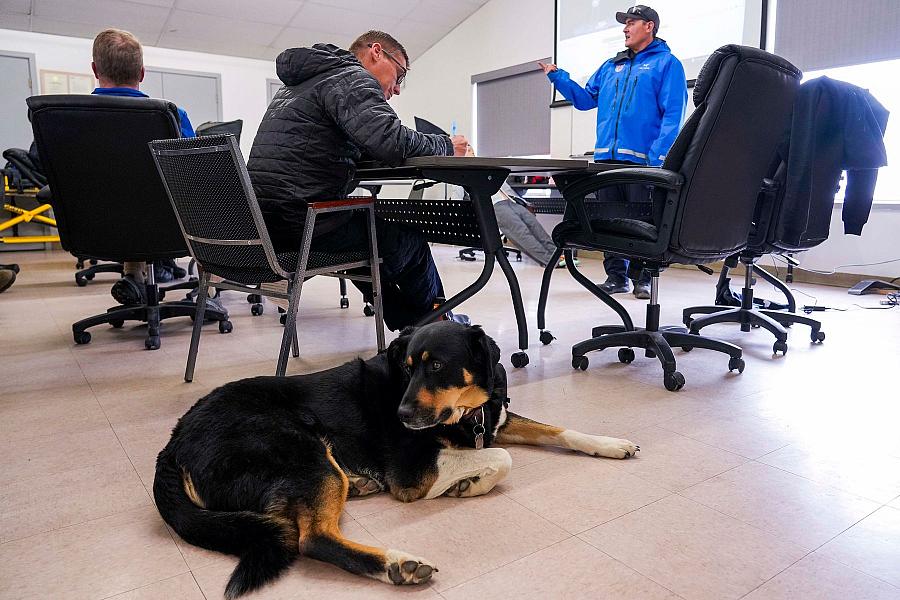
A firehouse dog relaxed as EMS and Fire Chief Rob Weisbaum (standing) addressed participants during a training meeting last April in Crested Butte, Colo. The public is encouraged to join for the regular twice-monthly Thursday-night trainings.
Smiley N. Pool / Staff Photographer
Malcolm said it’s the kind of money that can make or break an organization, especially as many EMS agencies nationwide grapple with scarce funding and staffing. Rural services tend to have so few calls, they cannot bring in enough revenue to attract paramedics and advanced emergency medical technicians.
The problem has grown so dire that in 2022 Colorado lawmakers created a task force to study ways to preserve and expand access to emergency care across the state, especially in areas that are far from high-level trauma centers.
Donnie Woodyard, former branch chief for emergency medical and trauma services for the state of Colorado and executive director of the EMS Compact, said EMS agencies in remote regions of Maine, Pennsylvania and other parts of the East Coast face similar challenges.
In most states, including Texas and Colorado, EMS is not classified as an essential service like police or fire departments, so municipalities are not required to provide access to emergency services.
Federal and insurance reimbursements for EMS do not fully cover the cost of having staff and ambulances available at a moment’s notice or stocking supplies — especially expensive ones like blood, experts say.
James Robinson, who spent more than two decades working in EMS in Denver, said he didn’t fully appreciate the challenges of providing emergency care outside of big cities until he moved to Loveland in northern Colorado, where he interacted with the volunteer-based services that operate in nearby rural areas.
He saw volunteer agencies struggle to recruit people for the stressful, often thankless job of responding to local 911 calls. Those who signed up usually lacked proper training and resources.
“They’re very dedicated to the people that they’re serving (but) are limping it by on sweat and Band-Aids and baling wire and duct tape to keep the service in place,” said Robinson, now the chief of Thompson Valley EMS.
That’s the experience of Jeff Schanhals, who volunteers as a paramedic for ambulance services in Haxtun and Yuma, rural towns in the northeast corner of Colorado that have a few hundred EMS calls each year. One of the services has paid staff to ensure 24/7 coverage. The other relies on the availability of a few volunteers who have other jobs.
On any given day they are stretched so thin, they risk having a call go unanswered.
Volunteers like Schanhals, who has been a paramedic for more than 30 years, are starting to age out of EMS work. In December, one of his friends was running calls until a few days before he died.
Schanhals knows the paramedics and emergency medical technicians who are graduating now aren’t interested in moving to his area, and even if they were, they would balk at the low salaries and skyrocketing housing costs.
If state and federal officials want a stronger EMS infrastructure, the money has to come from somewhere, Schanhals said.
In the meantime, Schanhals will continue to do what he’s always done: monitor his radio and, when a major trauma call comes in, keep his fingers crossed.
It’s a sentiment that paramedics across the state can relate to, considering the challenges inherent in their jobs.
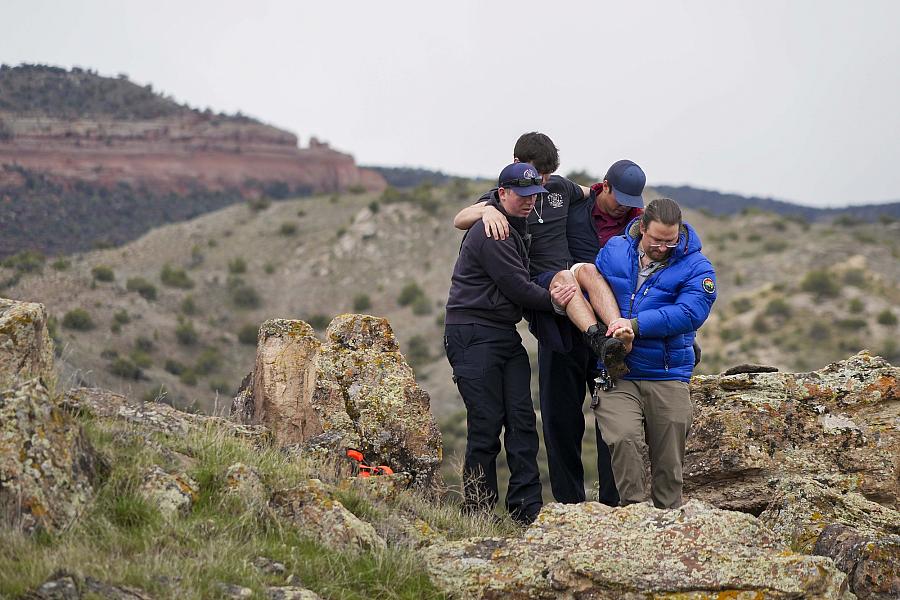
Burket(right), EMS medical director for Mesa County, acts as a bystander helping Lower Valley Fire District paramedics evacuate a patient in a backcountry training exercise near Fruita. 'If you're in downtown Dallas, you call an ambulance, you have five paramedics on scene in five minutes,' Burket Said
Smiley N. Pool / Staff Photographer
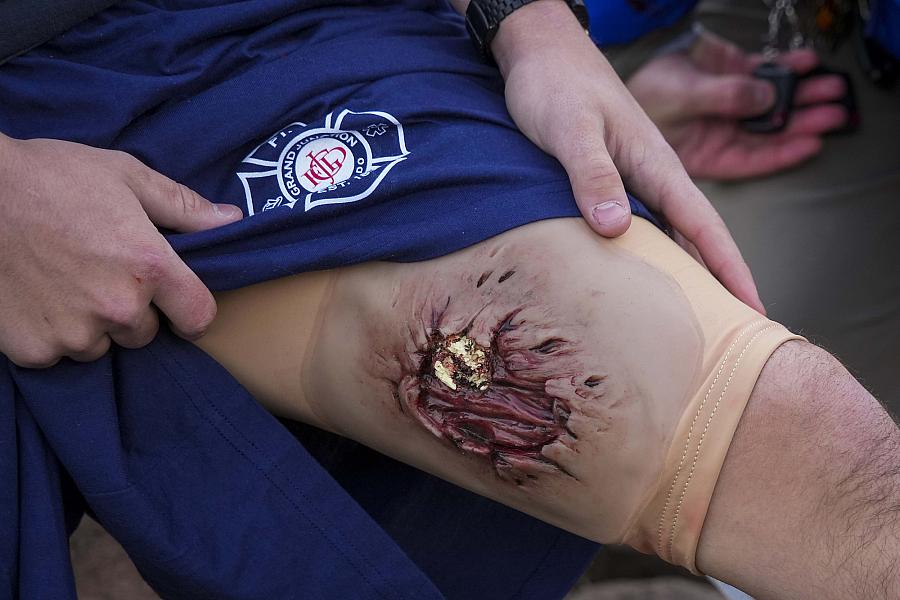
A Lower Valley Fire District medic puts on a device simulating a traumatic leg wound for a training simulation. Paramedics and emergency medical technicians who are graduating now likely aren't interested in moving to Western Colorado, where they will be met with low salaries and skyrocketing housing costs.
Smiley N. Pool / Staff Photographer

A role-player was evacuated from a rocky hillside during an EMS training exercise last April. Dramatic rescues are not unusual in rural areas of the American West, where the lie of the land can imperil emergency medical providers and the outcomes of the injured.
Smiley N. Pool / Staff Photographer
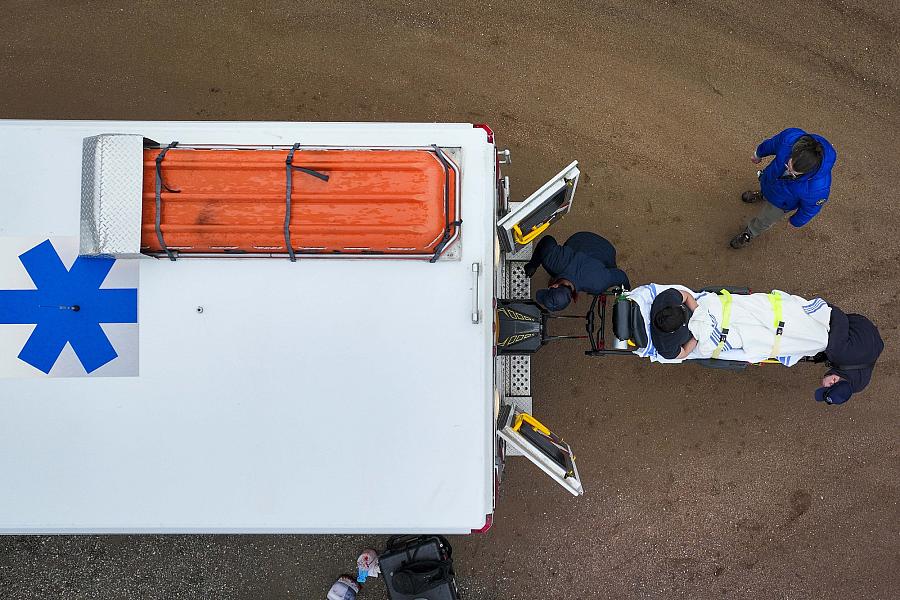
A role-player is loaded into an ambulance after being evacuated from a rocky hillside during an EMS training exercise near Fruita, last April. If state and federal officials want a stronger EMS infrastructure in remote, rural parts of the United States, the money has to come from somewhere, experts agree.
Smiley N. Pool / Staff Photographer
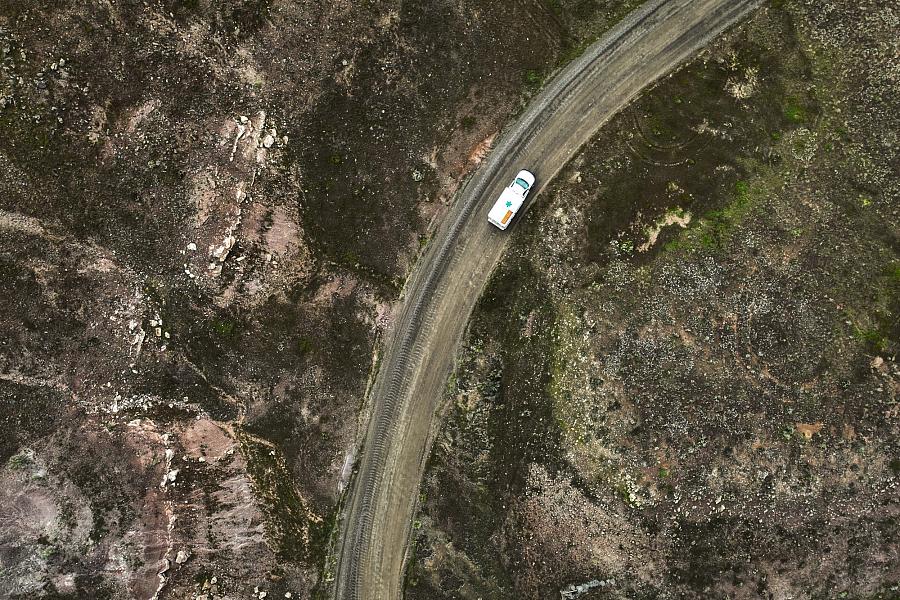
A Lower Valley Fire District ambulance drives a dirt road through the Horsethief Canyon State Wildlife Area after a training exercise near Fruita. In most states, including Texas and Colorado, EMS is not classified as an essential service like police or fire departments, so municipalities are not required to provide access to emergency services.
Smiley N. Pool / Staff Photographer
When the man was trapped in the ravine near Grand Junction, one of the first responders was Ben Linzey, a registered nurse and a critical care paramedic with the Lower Valley Fire District. He was certified to rappel down to the patient and give him blood, something he appreciated, considering how long it took to extricate the victim. Linzey estimated he didn’t return to his station until eight hours after the call came in.
Because of that, the man didn’t have to wait for care until he got to the top.
In a place like this, that can make all the difference.


